Autoclaved aerated concrete (AAC) is made with fine aggregates, cement, and an expansion agent that causes the fresh mixture to rise like bread dough. In fact, this type of concrete contains 80 percent air. In the factory where it is made, the material is molded and cut into precisely dimensioned units.
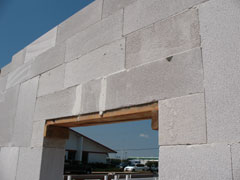
Cured blocks or panels of autoclaved aerated concrete are joined with thin bed mortar. Components can be used for walls, floors, and roofs. The lightweight material offers excellent sound and thermal insulation, and like all cement-based materials, is strong and fire resistant. In order to be durable, AAC requires some type of applied finish, such as a polymer-modified stucco, natural or manufactured stone, or siding.
Key aspects of AAC, whether designing or building with it, are described below:
Advantages
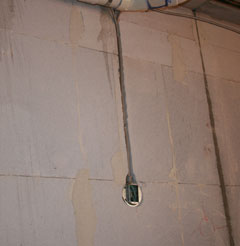 Autoclaved aerated concrete combines insulation and structural capability in one material for walls, floors, and roofs. Its light weight/cellular properties make it easy to cut, shave, and shape, accept nails and screws readily, and allow it to be routed to create chases for electrical conduits and smaller-diameter plumbing runs. This gives it design and construction flexibility, and the ability to make easy adjustments in the field.
Autoclaved aerated concrete combines insulation and structural capability in one material for walls, floors, and roofs. Its light weight/cellular properties make it easy to cut, shave, and shape, accept nails and screws readily, and allow it to be routed to create chases for electrical conduits and smaller-diameter plumbing runs. This gives it design and construction flexibility, and the ability to make easy adjustments in the field.
- Durability and dimensional stability. A cement-based material, AAC resists water, rot, mold, mildew, and insects. Units are precisely shaped and conform to tight tolerances.
- Fire resistance is excellent, with eight inch thick AAC achieving a four-hour rating (actual performance exceeds that and meets test requirements for up to eight hours). And because it is noncombustible, it will not burn or give off toxic fumes.
- The light weight means that R-values for AAC are comparable to conventional frame walls, but they have higher thermal mass, provide air tightness, and as just noted, are not combustible. That light weight also gives a high sound reduction for privacy, both from outside noises and from other rooms when used as interior partition walls.
But the material does have some limitations. It is not as widely available as most concrete products, though it can be shipped anywhere. If it has to be shipped, its light weight is advantageous. Because it is lower strength than most concrete products or systems, in load-bearing applications, it must typically be reinforced. It also requires a protective finish since the material is porous and would deteriorate if left exposed.
Sizes
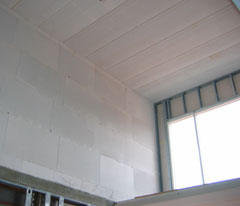 Both blocks and panels are available. Blocks are stacked similarly to conventional masonry, but with a thin-bed mortar, and panels are stood vertically, spanning full-story heights. For structural needs, grouted, reinforced cells and beams are placed within the wall section. (Concave depressions along vertical edges can create a cylindrical core between 2 adjacent panels.) For usual applications, a vertical cell is placed at corners, on either side of openings, and at 6- to 8-foot spacings along a wall. AAC averages about 37 pounds per cubic foot (pcf), so blocks can be placed by hand, but panels, because of their size, usually require a small crane or other piece of equipment.
Both blocks and panels are available. Blocks are stacked similarly to conventional masonry, but with a thin-bed mortar, and panels are stood vertically, spanning full-story heights. For structural needs, grouted, reinforced cells and beams are placed within the wall section. (Concave depressions along vertical edges can create a cylindrical core between 2 adjacent panels.) For usual applications, a vertical cell is placed at corners, on either side of openings, and at 6- to 8-foot spacings along a wall. AAC averages about 37 pounds per cubic foot (pcf), so blocks can be placed by hand, but panels, because of their size, usually require a small crane or other piece of equipment.
Panels extend from floor to top of the wall:
- Height: up to 20 feet
- Width: 24 inches
- Thickness: 6, 8, 10, or 12 inches (4 inches thick interior
Blocks are larger and lighter than traditional concrete masonry:
- Height: 8 inches typical
- Width: 24 inches long
- Thickness: 4, 6, 8, 10, and 12 inches
- A standard 8-by-8-by-24 inch unit weighs about 33 pounds;
Specialty shapes:
- U-shaped bond beam or lintel blocks are available in thicknesses of 8, 10, and 12 inches.
- Tongue and groove blocks are available from some manufacturers, and these connect to adjacent units without mortar at vertical edges.
- Cored blocks available for creating vertical reinforced grout cells.
Installation, Connections, and Finishes
Due to the similarity to traditional concrete masonry, autoclaved aerated concrete units (block) can be easily installed by concrete masons. Sometimes, carpenters get involved in installation. Panels are heavier due to their size and require the use of a crane for placement. Manufacturers offer training seminars, and it’s usually adequate to have one or two knowledgeable installers on small projects. Depending on the type of finish selected, they can be directly adhered or mechanically attached to the face of AAC.
Block
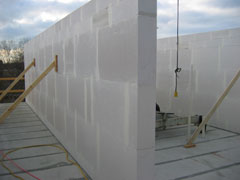 First course is laid and leveled. Blocks are stacked together with a thin-bed mortar in a running bond with a minimum of 6-inch overlap.
First course is laid and leveled. Blocks are stacked together with a thin-bed mortar in a running bond with a minimum of 6-inch overlap.- Walls are plumbed, leveled, and squared with a rubber mallet.
- Openings and odd angles are cut with a handsaw or bandsaw.
- Reinforcement locations are determined, rebar placed, and grouting occurs. Grout must be mechanically vibrated to consolidate it.
- Bond beams are placed at the top of the wall and can be used for heavy-duty fixture attachment.
Panels
- Panels are placed one at a time, starting from the corner. Panels are set into a layer of thin-bed mortar and vertical rebar is attached to dowels extending up from the floor before the adjacent panel is placed.
- A continuous bond beam is created at the top, either with plywood and AAC material or with bond beam block.
- Openings can be precut or field cut.
Connections
- Roof frame/framing is connected to a conventional top plate or hurricane straps embedded in the bond beam.
- Floor framing is attached with standard ledgers anchored to the side of the AAC assembly adjacent to a bond beam.
- AAC floor systems bear directly on top of AAC walls.
- Larger structural steel members are set on weld plates or bolt plates set into the bond beam.
Finishes
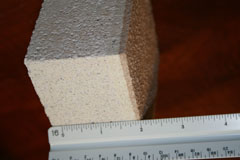 Stucco-type finishes are made specifically for AAC. These polymer-modified plasters seal against water intrusion yet allow moisture vapor for breathability.
Stucco-type finishes are made specifically for AAC. These polymer-modified plasters seal against water intrusion yet allow moisture vapor for breathability.- Conventional siding materials are mechanically attached to the wall face. Furring strips should be employed if back ventilation of the siding material is desirable.
- Masonry veneers can be directly adhered to the wall face or can be built as cavity walls. Direct-applied veneers are typically lightweight materials like manufactured stone.
Sustainability and Energy Considerations
Autoclaved aerated concrete offers both material and performance aspects from a sustainability perspective. On the material side, it can contain recycled materials like fly ash and rebar, which may help contribute to credits in LEED® or other green rating systems. Further, it incorporates such a large quantity of air that it contains less raw material per volume than many other building products. From a performance perspective, the system leads to tight building envelopes. This creates an energy efficient envelope and protects against unwanted air losses. Physical testing demonstrates heating and cooling savings of roughly 10 to 20 percent compared to conventional frame construction. In consistently cold climates, the savings may be somewhat less because this material has lower thermal mass than other types of concrete. Depending on the location of manufacturing relative to the project site, AAC may also contribute to local materials credits in some green building rating systems.
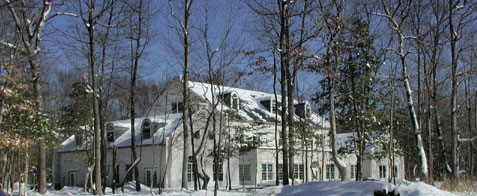
Manufacturing and Physical Properties
First, several ingredients are blended into a slurry: cement, lime, water, finely ground sand, and often, fly ash. An expansion agent like aluminum powder is added and the fluid mixture is cast into a large billet. As the slurry reacts with the expansion agent to generate air bubbles, the mixture expands. After its initial set, the resulting “cake” is wire cut into precisely sized blocks or panels and then baked (autoclaved). The heat helps the material to cure faster so that blocks and panels maintain their dimensions. Reinforcement is placed within panels prior to curing.
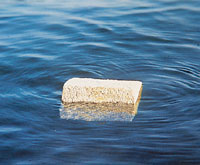 This manufacturing process produces a lightweight, noncombustible material with the following properties:
This manufacturing process produces a lightweight, noncombustible material with the following properties:
Density: 20 to 50 pounds per cubic foot (pcf)—this is light enough to float in water
Compressive strength: 300 to 900 pounds per square inch (psi)
Allowable shear stress: 8 to 22 psi
Thermal resistance: 0.8 to 1.25 per inch. of thickness
Sound transmission class (STC): 40 for 4 inch thickness; 45 for 8 inch thickness
Autoclaved Aerated Concrete
There is no trade association currently representing the Autoclaved Aerated Concrete industry. Manufacturing of AAC still exists in North America. We suggest you search the internet for dealer representatives that can assist you with potential product availability in your area.
AAC Projects
A Tale of Three Cities: The Residential Versatility of AAC
 The benefits of using autoclaved aerated concrete (AAC) are numerous. Perhaps in testament to the versatility of AAC, the three residential projects described here are quite different—but share a common theme of safety. A large single family home in a forest, whose construction is being managed by the owner himself; a modest single family home on a wooded site, designed by an architect seeking environmentally sound and healthy living; and a large development along the Louisiana Gulf Coast requiring superior weather resistance.
The benefits of using autoclaved aerated concrete (AAC) are numerous. Perhaps in testament to the versatility of AAC, the three residential projects described here are quite different—but share a common theme of safety. A large single family home in a forest, whose construction is being managed by the owner himself; a modest single family home on a wooded site, designed by an architect seeking environmentally sound and healthy living; and a large development along the Louisiana Gulf Coast requiring superior weather resistance.
Handal Home, Maryland: Simplicity and Safety
Set in a southern Maryland forest, this large residence (6,800 square feet) posed several construction challenges. So the owner, who is managing the construction himself, wanted a simple system. That turned out to be 12-inch AAC blocks. He needed their thermal insulating and noncombustible properties to stand up to the home’s forest setting, which included cold temperatures and, potentially, fire hazards. The simplicity of AAC, he says, allows him, in one step, to construct a structural wall that is insulated, resistant to termites, and ready for finishing. He didn’t want to attach a siding product, preferring instead direct-applied finishes: gypsum plaster for the interior and stucco for the exterior.
Dodson Home: Healthy and Serene
Some years ago, when architect Alice Dodson selected AAC to build her own home, it was partly for health and environmental reasons. A long-time sustainability advocate, she was also already following Bau-biologie. Relatively unknown in the United States, but well established in Europe among architects and health professionals, Bau-biologie is building biology or building for life. It resulted after rapid construction in post-war Germany led to what we now think of as sick building syndrome. So then, as now, she sought healthy building solutions. To that end, she selected AAC blocks and panels to achieve breathable masonry walls that emit no volatile organic compounds (VOCs). This creates an eco-friendly building, with a calming, quiet interior. And with her firefighter husband involved in the building process, having a noncombustible material was essential.
The AAC envelope also provides good thermal mass and insulation. Thanks to an energy efficient envelope complemented by solar panels and a wood stove, gas bills during the first year were only $100 for the 4,000-square-foot home. The home can stay warm for two to three days even after a disruption in power. Dodson likes how the material can be sculpted with woodworking tools into various shapes and elements, like columns and fireplaces, and continues to be a proponent of AAC with clients, who appreciate its versatility and aesthetic potential.
The Grove at Inlet Beach: Safety and Weather Resistance
This success story occurred as a result of destruction caused by Hurricane Katrina. As the Florida Panhandle’s first all-AAC high-density residential development, The Grove at Inlet Beach is intended to withstand future weather and safety challenges in its Gulf Coast environment. All walls, floors, and ceilings of these single family residences are made with AAC panels and blocks. The excellent fire rating (four hours for four inches) was key to local zoning approval, and there are no structural fire concerns as a result. When hurricanes arrive, these structures are prepared to meet 150 miles per hour (mph) winds (Category 4), and with proper reinforcement, can be engineered to withstand winds of 200 mph or more (Category 5). AAC homes are not destroyed by floods, either: they resist rising waters, rot, mold, and mildew and can be cleaned, repainted, and reopened to residents—no rebuilding necessary.
As if the security and weather resistance weren’t enough reason to select AAC for his own home, the developer anticipates saving 35 percent on his utility bills and 65 percent on his insurance premiums.
The Comfort of Concrete
 Some guests in a Georgia hotel are sleeping better tonight thanks to autoclaved aerated concrete (AAC). About an hour outside of Atlanta, the site for the Forsyth, Georgia, Comfort Suites, a slim lot adjacent to an interstate, posed a few challenges. And high land costs are making it increasingly common to build on sites that have inherent challenges such as noise, unlevel terrain, or minimal set-backs. So developers turned to a concrete system to help meet their needs for delivering a quality project—in this case, a strong, quiet, four-story structure near a heavily traveled highway.
Some guests in a Georgia hotel are sleeping better tonight thanks to autoclaved aerated concrete (AAC). About an hour outside of Atlanta, the site for the Forsyth, Georgia, Comfort Suites, a slim lot adjacent to an interstate, posed a few challenges. And high land costs are making it increasingly common to build on sites that have inherent challenges such as noise, unlevel terrain, or minimal set-backs. So developers turned to a concrete system to help meet their needs for delivering a quality project—in this case, a strong, quiet, four-story structure near a heavily traveled highway.
Read more on AAC.
Disclaimer
The listing of organizations and information resources constitutes neither an endorsement nor recommendation by the Portland Cement Association (PCA). PCA disclaims any and all responsibility for the selection of organizations listed and the products they represent. PCA also assumes no responsibility for errors and omissions in this list.